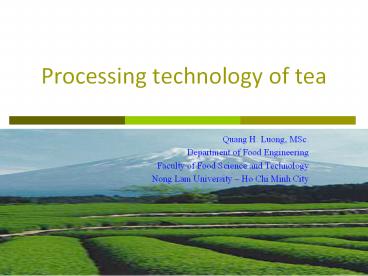Processing technology of tea PowerPoint PPT Presentation
Title: Processing technology of tea
1
Processing technology of tea
- Quang H. Luong, MSc.
- Department of Food Engineering
- Faculty of Food Science and Technology
- Nong Lam University Ho Chi Minh City
2
Course grading
- Seminar 30
- Midterm exam/Lab. Report/assignment 20
- Final exam 50
3
Contents
- General introduction of tea
- Flavonoids and other components of tea
- Technology of tea products (Green, black,
Oolong,teas)
4
History of tea
- Reading of reference materials
- Since 1690, E. Kaempfer named the bush Thea
sinensis - In 1753, C. Linné named Camellia sinensis
- Camellia sinensis (L.) O. Kuntze
5
Countries grow tea plant
6
World tea market share in 2009
Courtesy http//www.vietnam-tea.com/overview.html
7
Tea growing areas of Vietnam
Hà Giang,Tuyên Quang, Cao B?ng, L?ng Son Vinh
Phúc, Phú Th?, Son La, Hòa Bình, B?c Thái
Ngh? An, Hà Tinh, Thanh Hóa
Lâm Ð?ng, Gia Lai, Kon-tum
8
Teas and health benefits
- Tea as a panacea
- Anti-carcinogenic activity
- Lung cancer, prostate cancer, breast cancer, skin
cancer stomach, pancreatic, oesophageal, and
colon cancers - Anti-inflammatory and anti-microbial properties
- Dental and oral diseases
- AIDS
- Cardioprotective and neuroprotective properties
- Heart disease
- Parkinsons and Alzheimers diseases
9
Flavonoids and other components in tea
10
Forms of Catechin
OH
OH
OH
O
HO
O
R1
OH
C
X
OH
OR2
OH
(-)-Catechin R1 R2 H (-)-Gallocatechin R1
OH, R2 H (-)-Catechin gallate R1 H, R2
X (-)-Gallocatechin gallate R1 OH, R2 X
11
(-)-Epi form
OH
OH
OH
O
HO
O
R1
OH
C
X
OH
OR2
OH
(-)-Epicatechin R1 R2 H (-)-Epigallocatechin
R1 OH, R2 H (-)-Epicatechin gallate R1 H,
R2 X (-)-Epigallocatechin gallate R1 OH, R2
X
12
(No Transcript)
13
(No Transcript)
14
Technology of tea products
15
(No Transcript)
16
Core stages
Plucking
Preservation
Processing
17
Plucking of T-leaves and flushes
Courtesy http//tea-plucking.blogspot.com/
18
Categories of tea
- Based on fermentation level
- Unfermented tea (Green tea)
- Full fermented tea (Black tea)
- Partly fermented tea (Oolong tea, Pouchong tea)
- Based on tea-shape
- Loose, compressed form (tea brick), and powder
teas
- Based on processing-method
- Raw and scented teas
19
Courtesy http//greentealovers.com/greenteatypesc
hina.htm
20
Courtesy http//www.cookscorner.net/Tea/Antioxida
nts.html
21
Green tea processing
Tea leaves and flushes
Green tea product
Steaming/Panning
Rolling
Packaging
Classification
Drying
22
Oolong tea processing
Tea leaves and flushes
Oolong tea product
Sunned withering
Packaging
Indoor withering
Drying
Special rolling
Panning
23
OTD - Black tea processing
Tea leaves and flushes
Black tea products
Packaging
Withering
Rolling
Classification
Drying
Fermentation
24
Dried scented tea processing
Tea panning (MC 1.5 2wb)
Additive preparing (Drying, grinding)
Blending (15 min.)
Scented incubation (Temp. 80 - 85 oC)
25
Tea blending with fresh flowers
Tea
Flower
Mixing
Turning
Screening
Drying
Natural cooling
Flower mixing
Flower screening
Fresh flower scented tea
26
Soluble powder tea processing
Tea leaves and flushes
Rolling/Grinding
Extraction
Drying/steaming
Aroma stripping
Filtration
aroma
aroma
Freeze drying
Concentration
Spray drying
Soluble tea powder
Packaging
27
Tea extracts and their applications
- Strong infusions
- Strong infusion are made by soaking tea leaves in
alcohol/water mixtures (the catechin content is
about 2 w/v) - Soft extracts
- Soft extract are made by concentrating the
strong infusion to a water content of 20-25 (the
catechin content is about 20 w/w) - Dry extracts
- Dry extract are made by spray drying the strong
infusion after they have been concentrated to
40-50 solids (Catechin 25 w/w) - Partly purified extracts
- Purified catechins
28
Trends in studying and developing new products
from tea
Tea material
Study on bioactivity
Develop new T-products
In vitro
Sample
Study on animal
Commercial T-refine
mechanism, toxic, digest, dose,
Blingding
Study on human beings
Products from T-catechins
29
T-preservation
Table 1. Relationship between equilibrium MC of
tea and RH of air
RH of air () 30 45 60 62 70 80 85 96
EMC of tea () 5,8 6,7 8,7 9,0 10,4 12,2 14,8 20,5
30
T-preservation
Table 2. The effect of packaging vs. MC of tea
Types of packaging MC of tea () MC of tea ()
Types of packaging 0 After 30 days
Glass flask with head-pin 7,5 7,5
Tin box 7,5 7,5
Wrap by hands, 2 layers of paper 7,5 12,8
Carton box with T-paper wrapping 7,5 13,8
Carton box with anti-humidity paper 7,5 12,7
Control (T without-package) 7,5 14,0
31
T-packaging
32
End of lecture, continuing slides for reference
33
Free glutamate in foods
Green tea
34
(-)-Catechin
OH
OH
HO
O
H
OH
OH
35
(-)-Gallocatechin
OH
OH
HO
O
OH
OH
OH
36
(-)-Catechin gallate
OH
OH
HO
O
H
O
OH
O
C
OH
OH
OH
37
(-)-Gallocatechin gallate
OH
OH
HO
O
OH
O
OH
O
C
OH
OH
OH
38
Các d?ng (-)-Catechin
OH
OH
OH
O
HO
O
R1
OH
C
X
OH
OR2
OH
(-)-Catechin R1 R2 H (-)-Gallocatechin R1
OH, R2 H (-)-Catechin gallate R1 H, R2
X (-)-Gallocatechin gallate R1 OH, R2 X
39
(No Transcript)
40
(No Transcript)
41
Aroma bamboo rotationer
42
(No Transcript)
43
(No Transcript)
44
(No Transcript)
45
(No Transcript)
46
(No Transcript)
47
(No Transcript)
48
Flavonoids in tea
Green T.
Black T
49
(No Transcript)
50
Department of Food Engineering, FST, NLU

